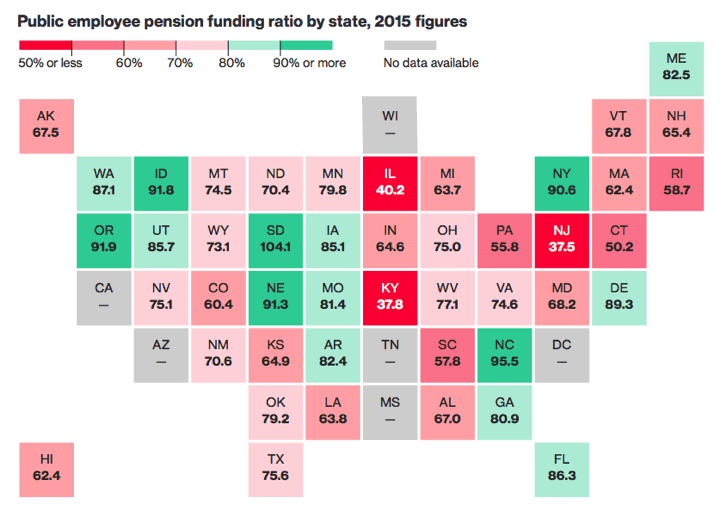The state of Illinois narrowly avoided having their S&P credit rating dropped to “Junk” status, but their current rating is already the lowest ever for any state. Their pension promises now total over $200 billion, but they are a bit short… $120 billion short. That’s only 40 cents saved for every $1 owed. Unfortunately, your state might not be doing that much better. Here is a Bloomberg graphic America’s Pension Bomb which shows the funding ratio for every state available:

This reminds me of a car wreck in slow-motion. Politicians get to make financial promises that can last 30-50 years, but they are only interested in being elected for the next 2-4 years. How will it end? Will states accept the pain now to fix things and get back on track? Or will they just keep kicking the can down the road until faced with huge tax hikes or maybe even a federal bailout?
If you are a municipal bond investor, Vanguard says not to worry: Despite Illinois’s financial troubles, muni market looks strong. Well, it’s good to see that Illinois is only about 1% of their national, investment-grade muni bond funds. I’m not worried about a crisis in the next few years either, but I also don’t see any evidence that things are getting better. I was planning to diversify my muni bond holdings anyway as my income drops in early retirement. Perhaps it’s time to speed up that timetable.
 The Best Credit Card Bonus Offers – 2025
The Best Credit Card Bonus Offers – 2025 Big List of Free Stocks from Brokerage Apps
Big List of Free Stocks from Brokerage Apps Best Interest Rates on Cash - 2025
Best Interest Rates on Cash - 2025 Free Credit Scores x 3 + Free Credit Monitoring
Free Credit Scores x 3 + Free Credit Monitoring Best No Fee 0% APR Balance Transfer Offers
Best No Fee 0% APR Balance Transfer Offers Little-Known Cellular Data Plans That Can Save Big Money
Little-Known Cellular Data Plans That Can Save Big Money How To Haggle Your Cable or Direct TV Bill
How To Haggle Your Cable or Direct TV Bill Big List of Free Consumer Data Reports (Credit, Rent, Work)
Big List of Free Consumer Data Reports (Credit, Rent, Work)
Illinois increased individual income taxes by 32% in the adopted budget. They said that there were also $3 billion in cuts. Turns out $1.5 billion was what they euphemistically called ‘smoothing’ that in reality was a cut to the pension contribution. If Illinois is a canary in the mine, it’s not going well for the canaries.
My spouse is eligible for NJ pension in 20 years. Right now I model us getting only 50% of the expected payout when I do my retirement planning. Maybe even that is too high. Fortunately we are saving heavily outside of the pension as well.
Interesting graphic. Based on pension funding alone, South Dakota, it would appear could be model for how government funding/spending should be.
This really is the tip of the iceberg. In addition to state pensions you have county & city pensions (which I’m guessing is a reason data for CA is n/a), union pensions and corporate pensions, the majority of which are significantly underfunded. My biggest concern is what implications this might have in a major “run on the bank” type scenario where instead of everyone pulling cash out of the bank, the hordes of baby boomers draw higher than expected amounts increasing amounts out of a deflating Market.
Lest people think these figures are written in stone: These projections are actually just based on total guesswork over decades and there is huge uncertainty in the figures.
Its like trying to decide if you’ll have enough money for retirement when you’re 30 years old. Lots of uncertainty based on multiple variables that you’re guessing about over the future decades.
My states funding level changed by 20% in just 2 years since this chart’s data.
I don’t mean to downplay the problem, but it should be clear that this isn’t about an absolute certainty that anyones running out of money any time soon or even ever.
Of course thats not to say that Illinois, Kentucky and New Jersey aren’t in deep trouble…
Don’t get me wrong, this is a major problem, but it looks much worse in this graphic than it actually is. Pension funds have assets (stocks, bonds, and other things) and they have liabilities, which are the pensions they have to pay in the future.
Today’s value of the assets is relatively easy to determine–just look at the account statements. But today’s value of the liability is a calculation of the present value of those future pension payouts. Simplistically, they take the future payouts and when they will need to be paid and discount them back to today using prevailing interest rates to get a present value of the total liability.
Since interest rates are at or near all-time low levels, that inflates the accounting value of those liabilities. If interest rates are at a more normal level in a few years, the present value of the liability will go down by a non-trivial amount even without having to cut pensions just because they would be discounted by more.